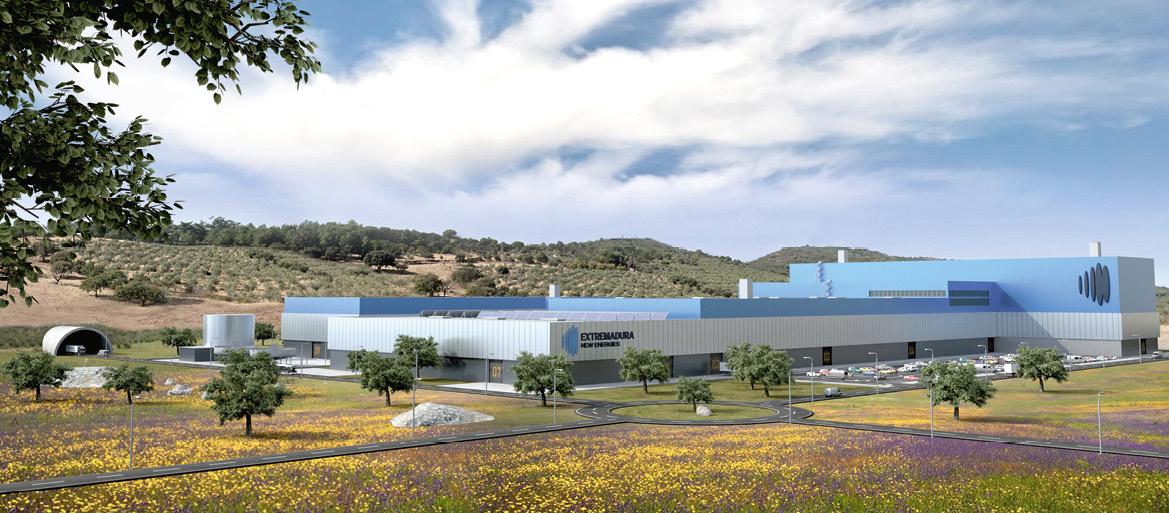From pv magazine 08/2022
Surrounding the town of Montealegre, in the north of Portugal and very close to the border of Spain, there is what is today considered Europe’s largest lithium deposit. This year, Portugal’s government has undertaken a series of actions to promote the development of the so-called Romano mine, in which the company Lusorecursos Portugal Lithium appears as the future exploiter. However, the proposed lithium mining operation is still mired in controversy and there is no clear date for its materialization.
Across the border in Spain, meanwhile, several lithium mining projects have been proposed in the province of Cáceres, some 400 kilometers south of Montealegre and still close to the border between the two Iberian nations. Two lithium mines, San José Valdeflórez and Las Navas, in the Extremadura region, are reportedly close to receiving concessions for their exploitation activities, although one project is more advanced than the other. In short, Spain and Portugal possess the two largest opportunities in Europe for lithium mining and subsequent processing into essential materials for the battery industry.
For now, Spain appears further ahead in moving to exploit these lithium resources. Alongside development of mining operations, plans for two battery gigafactories have been announced in the past two months: one in Sagunto, close to the city of Valencia that is being developed by Spanish car maker Seat and its parent company Volkswagen, and another in Navalmoral de la Mata, in the Extremadura region to the north of Cáceres. This one has been planned in a partnership between Chinese group Envision and Spanish company Acciona Energía.

San José Valdeflórez
One of the Spanish mines, San José Valdeflórez, proposed at a location not far from the town of Cáceres, has gone from being awarded by tender to the company Valoriza Minería, a subsidiary of the Spanish group Sacyr, to the hands of Australian mining company Infinity Lithium, which bought a 75% stake in the project.
This year a new company was established, Extremadura New Energies (ENE), a subsidiary of Infinity, which has been created so that the project is managed by a Spanish company, with some guarantee that the added value generated stays in Cáceres and the surrounding region. A representative of ENE told pv magazine that the project “is currently at an initial stage, and the administrative process has not yet started.”
Different problems regarding environmental permits and urban planning regulations from the Cáceres town council have brought the project to a standstill. And ENE has proposed modifications to the project to address local environmental concerns: the mine will be entirely underground, rather than earlier plans for an open pit, and it will be powered with renewable energy, potentially even producing its own green hydrogen.
ENE states that €500 million ($507 million) will be invested in the construction phase of a processing plant, and another €100 million in the subterranean mine itself – a two year process creating some 700 jobs.
The San José Valdeflórez project is now expected to produce its first ton of lithium hydroxide at the end of 2025, and then to be operational for close to three decades. Recent estimates place the project’s annual turnover at €340 million ($347 million), and a minimum return in taxes of almost €86 million per year, to be split equally between the regional government of Extremadura and the Spanish treasury. These estimates were made by ENE based on a lithium price of €17,000/ton ($17,350), while today’s price stands at around €70,000/ton.
Las Navas
Spain’s other project, the Las Navas lithium mine, is more advanced. The company Lithium Iberia is developing the mine as well as processing plants for both lithium and nickel at the Aguas Blancas mine in Monesterio, all located in Extremadura.
In addition, Phi4tech, a group of nanotechnology research and development companies, is promoting a battery cell pilot plant in the municipality of Noblejas, Castilla La Mancha. Together, this would create the first integrated energy storage manufacturing project in Europe.
As in the previous case, Lithium Iberia also had to update its plans to gain approval from regional authorities. A positive response is expected before the end of the year. In this case, the operating period is now 30 years, compared to the 19 years initially planned last year.
Investment cost for this project is €650 million ($663.5 million), and it comes with the creation of more than 1,600 jobs, both direct and indirect. Expected to begin operations in early 2025, Lithium Iberia forecasts an average annual production rate of 1.2 million tons of ore and more than 30,000 tons of battery grade lithium hydroxide.
In June 2021, an agreement was announced between Lithium Iberia and Phi4tech for the supply of lithium hydroxide for the creation of a battery factory. The project could be inaugurated 20 months after the start of the mining works, in five initial modules of 2 MW of manufacturing capacity each, requiring an investment of €80 million ($81.6 million) and bringing the creation of 200 direct jobs. Subsequent estimates are for the factory to reach 6 GW of production in 2024 and continue scaling up to a maximum capacity of 10 GW, creating 500 direct jobs and requiring an investment of €400 million ($408.3 million).
Phi4tech wants to create a state-of-the-art cobalt-free battery and supercapacitor hybrid that ensures fast charging, high durability, and extremely favorable chemistry with the best possible charge/discharge ratio.
Battery manufacturing
Spain currently hosts little battery manufacturing capacity, and what does exist is only the assembly of battery cells manufactured in Asia, which produces around 70% of the world’s batteries today. However, alongside the projects mining and processing lithium materials, major energy companies and auto makers are also moving forward with plans that could bring as much as 10% of the world’s battery manufacturing capacity to Spain.
In May 2021, German car manufacturer Volkswagen and its Spain-based subsidiary Seat received the starting signal for the construction of a giant factory in Sagunto, Valencia, which will cost €3.5 billion ($3.57 billion). At its launch event, which was attended by President of the Government of Spain Pedro Sánchez, it was said the objective is to have a capacity of 40 GWh, with a start date for operations in the first quarter of 2023, while series production will begin in 2026.
It should be noted that the construction of a solar plant has also been announced, which will occupy 250 hectares (more than the battery factory itself), which in the first phase will provide 20% of the gigafactory’s total energy.
A month after this announcement, the Chinese group Envision and Spanish company Acciona Energía said they had reached an agreement to build a second battery gigafactory in Navalmoral de la Mata, Extremadura, as part of a project to promote electric mobility in which a consortium of 12 companies from 10 Spanish autonomous communities will participate, mobilizing an investment of €1 billion ($1.02 billion). This plant will have an initial capacity of 10 GWh and will create 3,000 new jobs when it is fully operational in 2025. Both projects have been submitted to the PERTE VEC (Proyecto Estratégico para la Recuperación y Transformación Económica del Vehículo Eléctrico y Conectado) electric vehicle value chain program promoted by the Spanish government with European funds.
A third initiative, Basquevolt, is promoted by The Cooperative Research Center for Alternative Energies (CIC energiGUNE) together with the government of the Basque region and industrial partners including Spanish utilities Iberdrola and Enagás, among others. It aims to start production of solid-state lithium battery cells in 2027, with the goal of reaching 10 GWh of capacity. Basquevolt claims its technology will enable the mass deployment of electric transportation, stationary energy storage, and advanced portable devices.
The future of energy storage
Research institute CIC energiGUNE is specialized in energy storage, with projects working on batteries, thermal energy storage, and hydrogen technologies, among others. Since its beginnings in 2011, the institute has been based in Vitoria-Gasteiz, Basque Country. Nuria Gisbert has been the institute’s director general since 2015. “Research in energy storage is the core of our scientific activity,” Gisbert told pv magazine. She added that the continental recognition of the center assures that “we have a leading position in revolutionary technologies such as solid-state batteries and sodium batteries.”
Regarding the European framework, Gisbert said that Europe “has been investing three times more than China in the battery value chain” since 2019 to reach the goal of having a quarter of the market. In this regard, she said that “there are up to 30 battery gigafactory initiatives planned, and by 2030, Europe could have a production capacity of more than 1 TWh, which shows that the future of the market could be very different from the current situation.”
As for the future of lithium batteries, Gisbert said that “in the coming years it will be the automotive industry that will be the largest manufacturer of lithium batteries, and therefore the one that will take direct or indirect control of this material,” which will make it more difficult for manufacturers of other applications to access lithium batteries.
The tight supply of lithium has resulted in large manufacturers beginning to evaluate complementary or alternative chemistries, such as sodium, or redox flow batteries she said. “In this sense, sodium-based batteries are arousing a lot of interest due to their performance and the evolution they are expected to have in the coming years, positioning themselves as a real alternative to lithium-ion batteries in stationary applications and complementary in other applications.”
“In the future,” said Gisbert, “there will be different technologies coexisting for different applications with a clear trend towards hybridization of storage technologies.”
This content is protected by copyright and may not be reused. If you want to cooperate with us and would like to reuse some of our content, please contact: editors@pv-magazine.com.




Waste of resources on lithium battery technology for energy storage that causes environmental pollution, the future of energy storage will be in pumped energy or energy storage in compressed air.